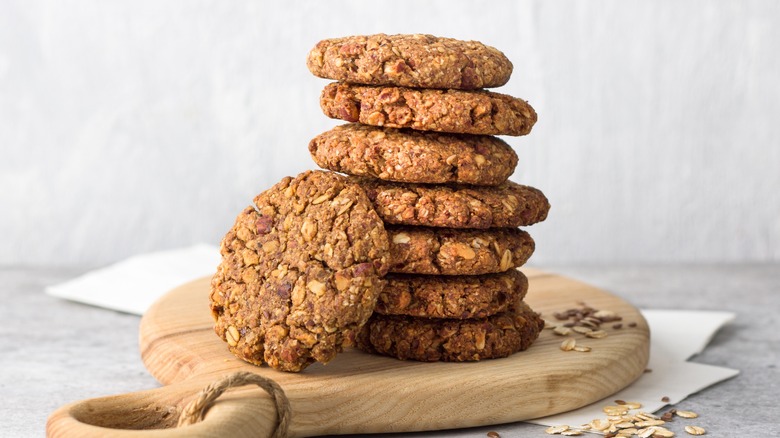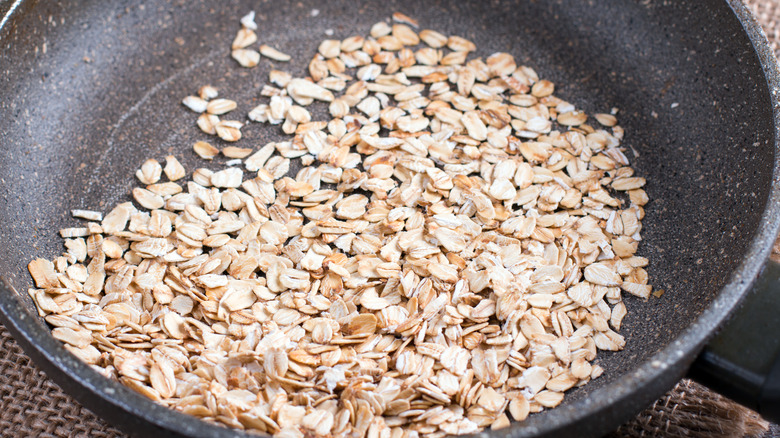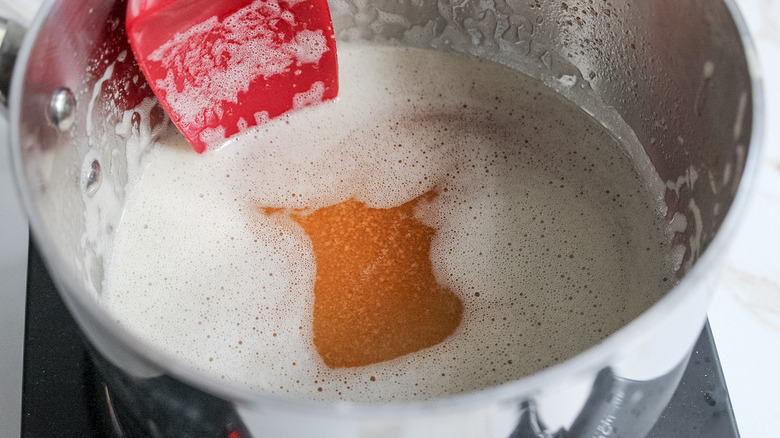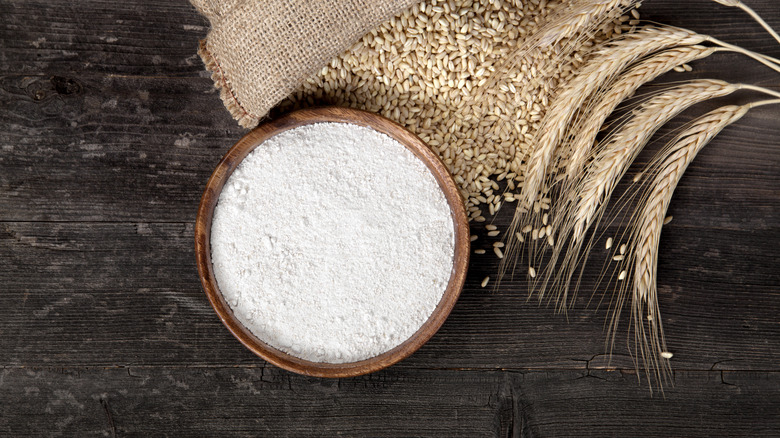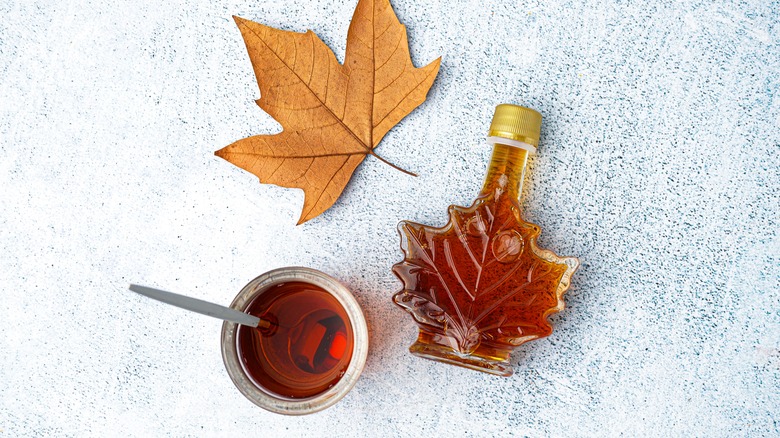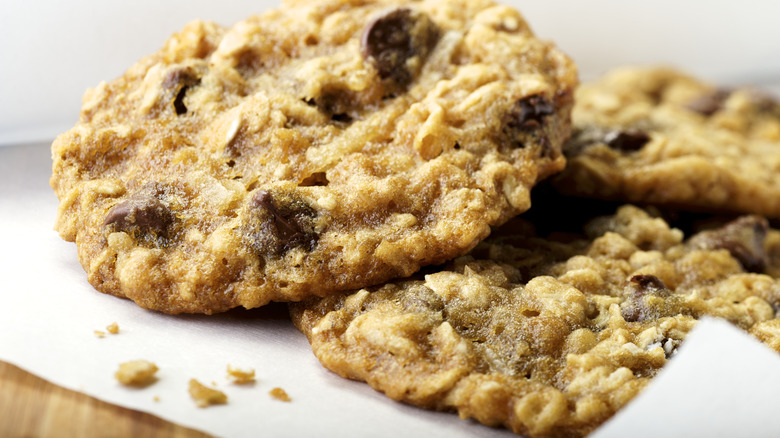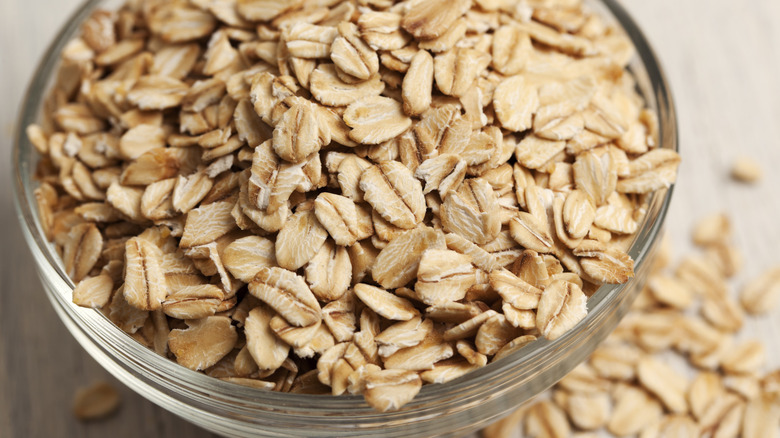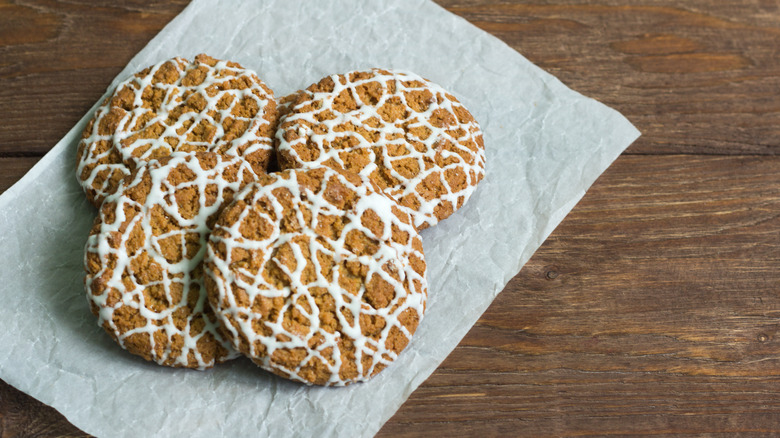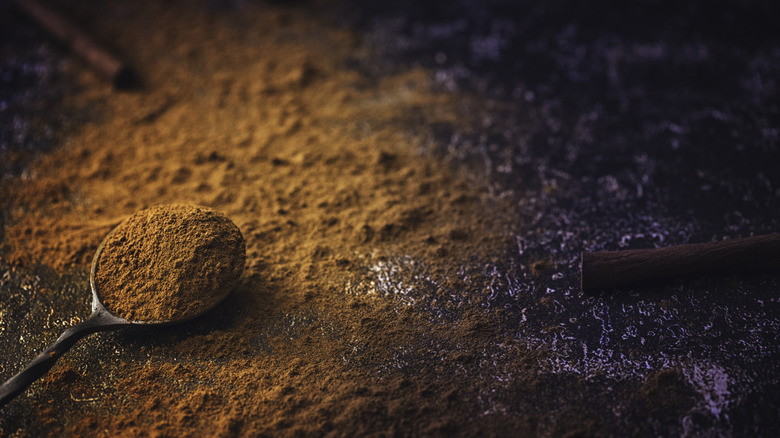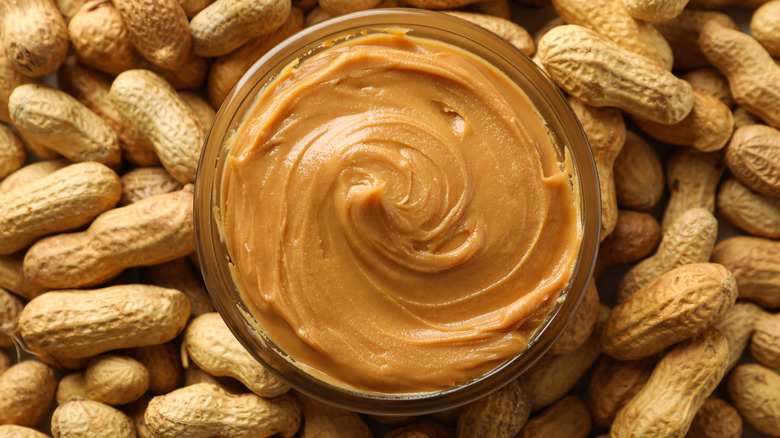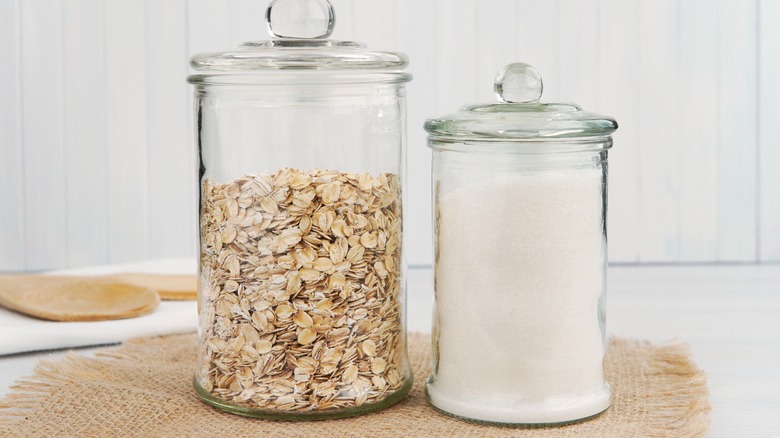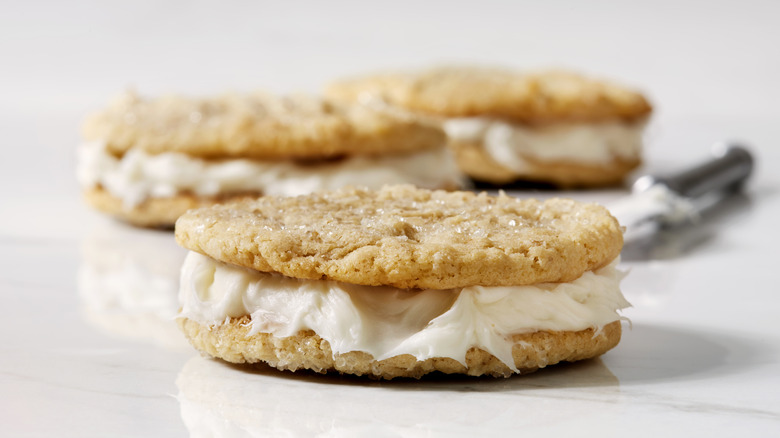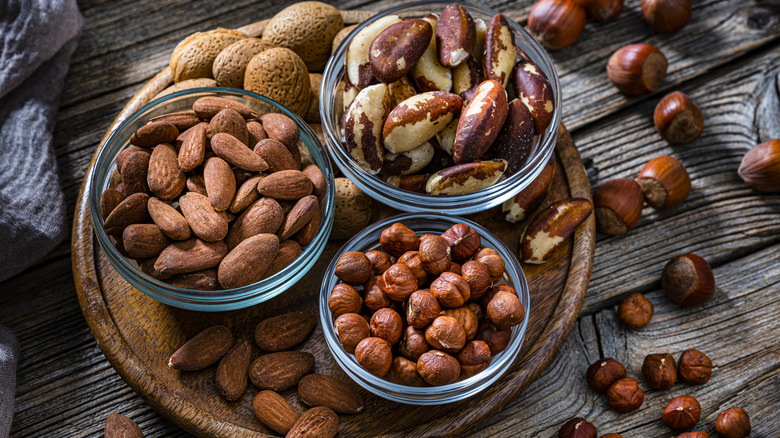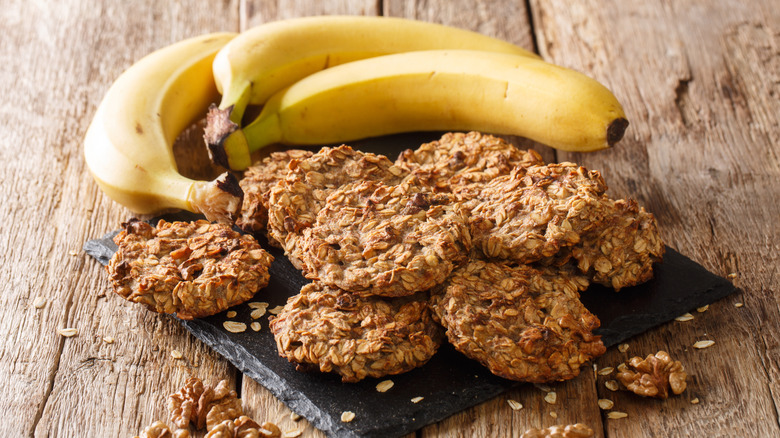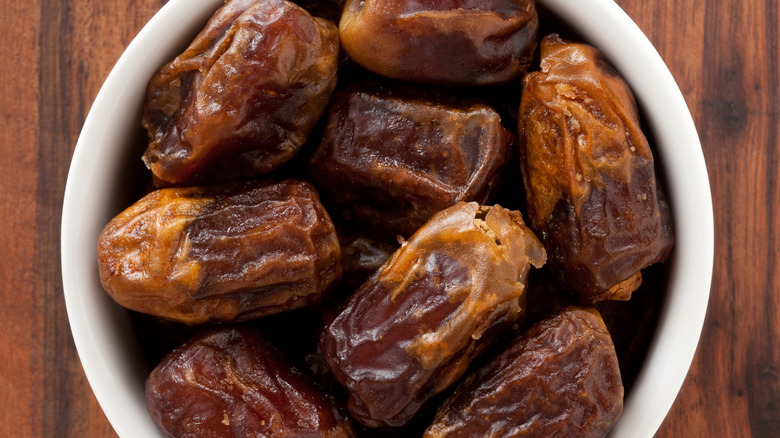Tasty Upgrades That Will Make Oatmeal Cookies Irresistible
Of all the types of cookies out there, oatmeal ones likely rank somewhere in the "meh" range for many people. Oatmeal cookies certainly aren't the worst thing in the world, but they aren't the tastiest treat you could bite into, especially when fan favorites like chocolate chip, snickerdoodles, or sugar cookies are in the running. Perhaps oatmeal cookies are too reminiscent of breakfast food to be enjoyed as a dessert, or perhaps they're just a little too plain for people to get behind. Whatever the case may be, we've got some good news: It's really easy to jazz up oatmeal cookies, and there are plenty of upgrades to suit your preferences and taste buds.
Whether you're looking for a simple or complex upgrade, this list will help improve your cookie game tenfold. Best of all, the key (or at least a key) to better oatmeal cookies is likely already sitting in your pantry, so if you aren't the most seasoned baker, fear not. Enhancing your oatmeal cookies can be as simple as sprinkling in spices and adding chocolate chips, or as complex as toasting the oats and browning the butter — play around to see which combination of upgrades works best for you and your cookies.
Toast the oats
If you're not looking to add extra ingredients to your oatmeal cookies, then toasting the oats is a great way to switch up the flavor. When you toast oats on the stovetop, they become, well, toasty — slightly browned, warm, and nutty in flavor. And, if we're being honest, oats aren't exactly packing in much flavor to begin with, so this small but easy step does wonders in enhancing the foundation of your cookies.
As long as you've got a pan and a stovetop, you can toast oats in a matter of minutes. If you'd like, you can use a cooking fat like butter or neutral oil to help the process along (and perhaps aid in extra caramelization), but this isn't strictly necessary. Simply spread the oats out in the pan and place them over medium-high heat; cook for a few minutes, stirring occasionally, until the oats start to brown and smell nutty. They might just even start smelling like cookies, and if that isn't a sign that you should use toasted oats in your oatmeal cookies, we don't know what is.
Brown the butter
Much like toasting the oats, browning butter will also give your cookies a warm, nutty flavor profile — both of which happen thanks to the Maillard reaction. Now, not every cookie recipe is going to call for using butter, though most of them do call for using some sort of fat. So, if you want to give brown butter a swing you can specifically find a recipe that calls for using butter or you can swap out whatever oil it calls for; your cookies will taste a bit different, but that's the whole point.
It's easy to make mistakes when browning butter — like letting the butter burn or not stirring enough — but the overall process isn't too complicated. You'll start by placing the butter in a saucepan over medium heat, then you'll continuously stir as the butter melts and starts to brown. It should only take a few minutes from start to finish, and once the butter starts to smell aromatic and nutty, you'll know it's time to cut the heat. If your cookie recipe doesn't specifically call for using melted butter, then be sure to give your fresh brown butter a chance to cool down before adding it in with the rest of the cookie ingredients.
Use oat flour for chewier cookies
Certain types of flour might work better than others in specific baking contexts, and when it comes to oatmeal cookies, oat flour might just be the supreme option. It may seem like a no-brainer to use oat flour in an oatmeal cookie recipe, but realistically, most folks are reaching for all-purpose when it comes to making cookies — and, for what it's worth, all-purpose gets the job done just fine. However, if you want chewier oatmeal cookies, oat flour may be the missing key.
Oat flour not only enhances the chewiness of your cookies, but it might make them fluffier, too. As an additional bonus, oat flour will make your cookies gluten-free, so it's an ideal swap for those who have certain dietary restrictions. You may need to experiment a bit to find the proper ratio when using oat instead of all-purpose flour, but start with a 1:1 ratio and make adjustments from there, if needed.
Sweeten the cookies with maple syrup
Just about any cookie recipe is going to call for some sort of sweetener. Most of the time, granulated sugar is the sweetener in question, though you may also see brown sugar, honey, or even powdered sugar thrown into the mix. A sweetener that often goes overlooked is maple syrup, though as it turns out, it just might be the key to transforming your oatmeal cookies from something good to something amazing.
If you've ever perused the syrup section at your grocery store, then you know that not all syrups are created equally. If you can, try to find Grade B maple syrup to give your cookies the richest, most intense flavor possible. But, in a pinch, any maple syrup (as long as it is real maple syrup) will do the trick; not only will the gooey stuff sweeten your cookies, but it'll add that classic maple flavor that granulated sugar just can't compete with.
Add chocolate to the mix
We've yet to stumble across a baked good that chocolate chips can't enhance, and oatmeal cookies are no exception. Though raisins may be the most common oatmeal cookie add-in, oatmeal chocolate chip cookies have a rightful place in this world. Not only do you add a touch of sweetness when you throw chocolate chips into your oatmeal cookie batter, but you also add a certain richness and, of course, plenty of chocolatey goodness. Simply put, chocolate chips make your oatmeal cookies much more flavorful and much more complex.
While chocolate chips are the natural go-to if you want to add such a flavor profile to cookies, why stop there? If you only have a chocolate bar on hand, simply chop it up and throw the chunks into the batter. If you forget to toss chocolate into the batter, fear not; melt some chocolate and drizzle it over baked, cooled cookies for a chocolatey addition that both tastes and looks good.
Opt for old-fashioned oats
If you consume oats often, then you may already know that there are different kinds out there, like old-fashioned, steel-cut, and quick-cooking oats. Though you can technically bake any type of oat into a cookie, there's one kind in particular that would give you the chewiest result, and that would be good old-fashioned oats.
Similar to the way old-fashioned oats take longer to cook than quick oats do, cookies with old-fashioned oats need more time in the oven. Those made with quick oats will turn out, but they'll be quite moist since quick oats absorb water so quickly. There's nothing wrong with a soft cookie, but when it comes to oatmeal cookies specifically, chewy is the supreme texture. If you want to double down on the chewiness of your cookies, soak the old-fashioned oats in water (then drain) before baking them to create the ultimate chewy confection.
Drizzle the cookies with icing
A big complaint about oatmeal cookies is that they aren't sweet enough; though there is sugar in the mix, the cookies certainly don't reach sweetness levels that counterparts like snickerdoodles or sugar cookies manage to. Instead of overloading your batter with more sugar, there's an easy way to sweeten up cookies after they bake, and that's by drizzling them with icing.
Cookie icing can be as simple as powdered sugar and water mixed, or you can go for a more complex lemony cookie icing (that still only requires three ingredients) to add a citrusy flair to your oatmeal cookies. You can also experiment with various flavors of extract like vanilla, maple, or almond to make your icing a little more exciting. When it comes time to frost the cookies, you have a few options depending on how pretty you want the cookies to turn out. You can use a piping bag to delicately adorn lines across each cookie, or you can simply use a fork or other utensil to drizzle the icing across. Another option is to turn the cookie over and completely dunk the top of it in icing — this will result in an ultra-sweet and ultra-tasty oatmeal cookie.
Spice up the cookies
Spices and seasoning make everything taste better, and oatmeal cookies are no exception. Depending on the recipe you follow, there's a good chance that the only seasoning it calls for is a pinch of salt — and, to be fair, that is technically all you need to yield a tasty cookie. Well, a slightly boring cookie, but one that gets the job done nonetheless. If you want to liven things up without having to put forth any extra effort (okay, maybe just a few seconds' worth of effort), then opening up your spice pantry is the best route to take.
Naturally, cinnamon might be the first spice that you reach for, as it is an absolute staple in the baking world and adds a subtle warmth to any treat that it graces. If you want to branch out and get creative with your spices, consider adding a pinch of cloves for a more pungent warmth or nutmeg for a subtly sweet, nutty addition. Or go all-out and add pumpkin pie spice to your oatmeal cookie batter for a smorgasbord of flavors including cinnamon, nutmeg, ginger, cloves, and allspice.
Add peanut butter for a rich and nutty touch
Peanut butter cookies are a thing all of their own, and we're not trying to steal their thunder here. That said, it is pretty easy to mix and match ingredients to make your perfect cookie, and that's exactly what we suggest you do to create a peanut butter oatmeal cookie. Think about it: Oatmeal cookies don't have a particularly strong flavor on their own, and peanut butter cookies taste very nutty but don't necessarily have a memorable texture. Combine the two, and voilà — you've got a cookie that tastes great and is irresistibly chewy all in one bite.
Now there are a few ways you could incorporate peanut butter into your oatmeal cookies. The first way, and perhaps the most obvious one, is to add some peanut butter directly to the cookie batter. This may take some experimentation to ensure that your cookies will still hold up with the addition of excess oil; so play around and be sure to refrigerate your rolled-out cookies before baking to give them the best shot at not spreading in the oven.
If you don't want to mess with the delicate balance of your cookie dough, then consider incorporating peanut butter after the baking phase. Melt peanut butter to make it more liquidy then drizzle it on top of your cooled cookies — simple but deliciously effective.
Roll the cookies in a sugary oat mixture
Do you ever bite into an oatmeal cookie and find yourself longing for a little more crispy-crunchy goodness? Sure, an ideal oatmeal cookie is chewy yet soft, and we're not suggesting that you attempt to make your cookies outright crunchy and hard; instead, we're suggesting a little crunch on the outside of the cookie. And, as it turns out, it's pretty easy to achieve said crunch, and the only two ingredients you need are ones already used in the cookies themselves.
To add extra crunch to your oatmeal cookies, all it takes is rolling the unbaked cookie balls in a mixture of oats and sugar. Demerara sugar is ideal if you have it on hand, but granulated sugar will work just fine, giving the cookies a slight crispiness on the outside à la snickerdoodles. Keep in mind that this hack won't give you super crunchy cookies, but it will add some textural contrast on the outside of your baked cookies and enhance the overall snacking experience.
Turn the cookies into sandwiches
The only thing better than one cookie is two cookies, and the only thing better than two cookies is two cookies with a thick layer of frosting binding them together. Yes, we're talking about cookie sandwiches, and we'd argue that there's no better cookie candidate for a sandwich than oatmeal ones. Oatmeal cookies hold their shape well, so you don't have to worry about them crumbling as you try to assemble the sandwiches. And since oatmeal cookies are pretty neutral on their own, there's nothing like a layer of buttercream to help sweeten up the deal.
Though this upgrade doesn't necessarily affect the cookies themselves, it does provide an optimal way to improve your oatmeal cookie-eating experience. Of course, vanilla buttercream is perhaps the most obvious ingredient to sandwich between two cookies, but you could also take a fruity route and opt for raspberry or strawberry jam. Better yet, you could do an initial layer of buttercream and spoon some jam or compote in the middle — so once you get to the center of your oatmeal cookie sandwich, there'll be an extra sweet surprise waiting.
Add nuts and seeds
If you're looking for a way to add a true crunchy factor to your oatmeal cookies, then nuts are the foolproof option. Sure, it may seem obvious to add nuts to cookies, but if you always go the oatmeal raisin route, then perhaps you've never considered the fact that you can swap those raisins for chopped walnuts, pecans, almonds, cashews, or even macadamia nuts. With the oatmeal cookie providing a chewy base, chopped nuts will add just enough crunchiness to transform the texture of your treats all while adding a nice nutty flavor, too.
Don't be discouraged if nuts aren't an option for you due to allergies or dietary restrictions — crunchy goodness still awaits your oatmeal cookies. Seeds — like pumpkin or sunflower — are just the solution to enhancing the texture of your cookies while keeping them nut-free. Now we can't say that your cookies will be quite as crunchy as they would be with nuts, but there will still be a notable bite if you use the right seeds. If you aren't concerned with crunchiness, you could toss in chia seeds or flax seeds for a nutritional boost.
Add mashed or grated fruit to the mix
Whether you've got some browning bananas that need to be used up or you want to incorporate more fruit into your diet, oatmeal cookies are a great vessel for sneaking fruit in. One of the best options is the humble banana, which certainly isn't a stranger to the baking world. Though bananas most often find themselves baked into bread, you can easily mash up a super-ripe banana and incorporate it into your oatmeal cookie mix for some added fruity sweetness.
Another fruit (yes, it's technically a fruit) that would work in oatmeal cookies is zucchini. Another food that has had a foray or two in the baking world, zucchini adds plenty of moisture to any baked good that it graces. This means that your cookies will be ultra-moist and speckled with green, but otherwise, zucchini won't affect the flavor of the cookies too much.
Finally, you could chop up some pears and throw them into your cookie batter, too. Pears would add subtle juiciness and sweetness to your cookies, perfectly complementing the oaty flavor without overpowering it. You might be so inclined to pair pears with white chocolate for an extra sweet treat à la this pear oatmeal cookie recipe.
Swap out raisins for dried dates
When in doubt, it's easy to reach for raisins as a tried and true complement to oatmeal cookies, but what if we told you there was a better option out there? Though it's somewhat of a subjective matter, consider swapping raisins for dates in your next batch of oatmeal cookies. Why? Well, for one, dates are less tough than raisins, and many folks liken the flavor to that of caramel or honey. Not only that, but the dates will change a bit as they bake — unlike raisins, which will stay tough and chewy — and will meld with the cookie, becoming irresistibly soft and perfectly sweet.
Now, if dates absolutely aren't your thing, you've got other options in the dried fruit department. Dried cranberries are a natural swap for raisins, offering up a similar mouthfeel and a slightly more tart flavor profile. Another tart go-to is dried cherries, which will not only influence the flavor of your oatmeal cookies for the better, but will make them look prettier too.
